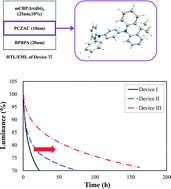Long lifetime blue phosphorescent organic light-emitting diodes with an exciton blocking layer
Abstract
An acridine derived compound, 9,9-dimethyl-10-(9-phenyl-9H-carbazol-3-yl)-9,10-dihydroacridine (PCZAC), was newly designed as a hole transport type high triplet energy material for application as a hole transport type exciton blocking layer of blue phosphorescent organic light-emitting diodes. The PCZAC compound provided a high triplet energy of 2.99 eV and a high glass transition temperature of 101 °C for high efficiency and long lifetime. PCZAC showed an improved quantum efficiency and more than 8 time improvement of the lifetime of blue phosphorescent organic light-emitting diodes.


 Please wait while we load your content...
Please wait while we load your content...